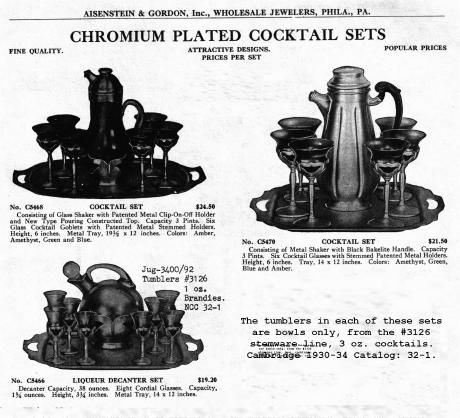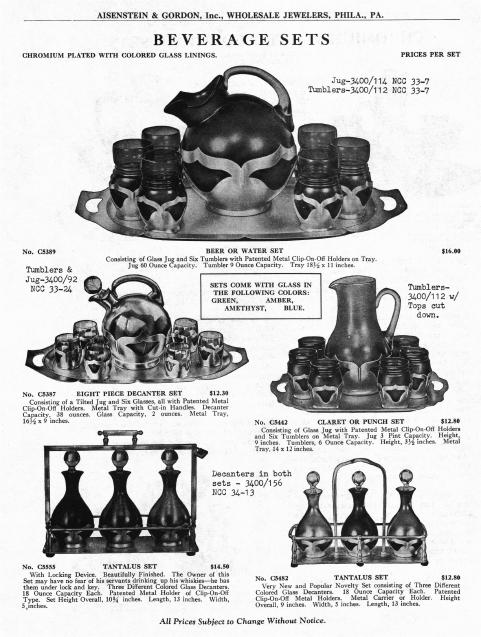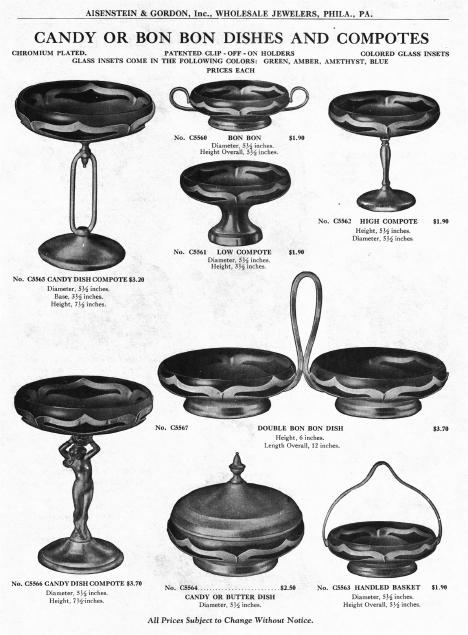Farberware
by Bill Smith
Issue 60 - April 1978
Cambridge Glass information is out there to be found. It is just a matter of being lucky enough to stumble upon some of the less obvious hiding places.
The following pages are copies of pages that have been taken from a 1935 issue of a wholesale jewelers catalog issued by Aisenstein and Gordon, Inc. of Philadelphia Pa.
Having no knowledge of the Aisenstein and Gordon organization we will limit our discussion to the printed word as it appears on the catalog pages and to other background knowledge that has surfaced.
In the description of the various items or sets, there is no reference at all, to the Farber Bros. Co. of New York, or to the Cambridge Glass Co. There are several items that mention the "Patented Metal Clip-On-Off holders". This method of inserting glass into metal holders was patented by the Farber Bros. Co. and having established this point we will couple this information to the discussion that was presented by Mr. Eugene Henn at our 1975 Convention. In his talk Mr. Henn brought out the fact that Farber Bros. was one of the largest buyers of custom work from the Cambridge Glass Co. and that it was also one of the companies that did a very great deal toward keeping Cambridge working during the depression era.
Other companies also supplied custom fitted parts for Farber attachment, but where ever we can identify a particular shape as being from a Cambridge mold or when we can identify a color as Cambridge, we can accept fairly comfortably the opinion that the item was produced by Cambridge. In these following pages we can see that all of the items shown have a distinct similarity to other item components of Cambridge manufacture. The color references from this black and white printed page does not help us much, but some credence can be allowed in the fact that all of the colors mentioned are colors that were produced by Cambridge.
 Many of the items shown, on these pages can be identified from our
1930-34 Catalog. In this identification, some latitude is required in
the stated volume of the containers. We cannot say whether this is the
result of differences in the methods used to establish the volume, or
whether it could have come from some additional capacity being created
in the specifications provided to Cambridge by the Farber Bros. Co. The
latter does not seem to be a potential answer in the case of the Ball
decanter and the Tantalus flask.
Many of the items shown, on these pages can be identified from our
1930-34 Catalog. In this identification, some latitude is required in
the stated volume of the containers. We cannot say whether this is the
result of differences in the methods used to establish the volume, or
whether it could have come from some additional capacity being created
in the specifications provided to Cambridge by the Farber Bros. Co. The
latter does not seem to be a potential answer in the case of the Ball
decanter and the Tantalus flask.
The Ball decanters shown in items numbered C-5466 and C-5387, are most probably the #3400/92 shown on page 33-7 of the NCC 1930-34 Reprint, or C-5387 could be the complete set shown on page 33-24. Instead of listing each item of this nature, we have made notations on each of the sets as to their probable reference.
We were unable to directly associate the Bon Bon dishes and Compotes to any particular catalog reference. It is interesting to note that the Farber Bros. Co. did utilize the Cambridge Nude into their wares in a comparatively short time after this stem was introduced by Cambridge.
For additional comparison and review, we would remind you of the Farberware Article by Gwen Shumpert, that appeared In the May, 1976 CRYSTAL BALL.
We would also remind you that the CRYSTAL BALL is always interested in any Cambridge related items that any or you may find and would be desirous of sharing with the other members of the club. In such instances, please include with your correspondence the source (name of magazine, book or brochure), as well as any dates that would apply, such as the publication date. etc.
Any material submitted would he greatly appreciated by the CRYSTAL BALL staff and in most instances could be returned to you after publication, if so desired.



